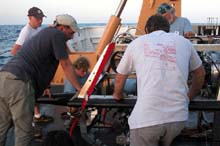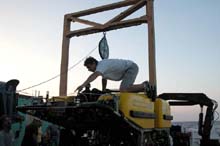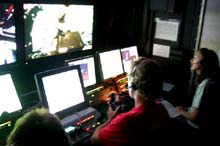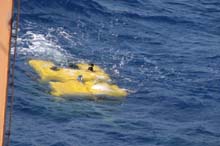
The Remotely Operated Vehicle (ROV) Hercules searches for deep sea fauna. Click image for larger view and image credit.
The ROV Hercules is oriented back to back with the ship while the ROV Argus is lifted in to the water. Click image for larger view and image credit.
Anatomy of an ROV Dive
August 26, 2005
Brennan Phillips
Institute for Exploration
It's easy to take for granted the technology that goes into a deep-sea ROV expedition, especially when the end results are images, video and samples of intriguing and rarely seen deep-water fauna. On a cruise like this, where we are launching and recovering the vehicles nearly every day, the whole operation seems routine. When one looks back at all the pieces that must come into place before the ROV can collect a coral sample in depths of up to several thousand meters, it's easy to see that it is anything but.
Before HERCULES can go in the water, a rather intensive pre-dive checklist must be completed. This usually takes two people; one to sit inside the control van and push buttons, and one to work out on deck and visually make sure things are set to go. Using radio headsets, these two people work through all of the necessary details, including:
Are all of the cables and hoses secured? (If they aren't, one could come loose and get cut in a thruster.)
Are there any leaks in the hydraulic system?
Are all of the lights turning on and off? (These things can be finicky.)
Are all of the thrusters mounted firmly in place? (I don't even want to think about it!)
There are many things to check out and be sure of. The whole pre-dive operation takes about two hours to complete, and it is a ritual before every dive, no matter how short or long the last one was.

The Institute for Exploration (IFE) team checks out the ROV Argus. Click image for larger view and image credit.

Todd Gregory of the University of Rhode Island checks out the ROV Hercules while Catalina Martinez, of NOAA looks on. Click image for larger view and image credit.
The pilots rely on a navigator to keep track of where the vehicles are relative to the ship, and to maintain communication with the bridge concerning where we need to go. This requires the navigator to use some highly sophisticated tools. I like to think of it as a dance: the navigator moves the ship to where it needs to be, the Argus pilot spins around to keep a camera on Hercules, and the Hercules pilot drives the ROV into a precise location determined by the scientists. All of this must come together with the precision required to focus on, for example, a sea spider that is only a couple of centimeters long, in 2000 meters of water!

Brennan Phillips of IFE looking over the ROV Hercules, post dive. Click image for larger view and image credit.

Todd Gregory of the University of Rhode Island (URI) pilots the ROV Hercules, while Alicia Caporaso of URI navigates on the Verrill Seamount. Click image for larger view and image credit.
Towards the end of a dive, the ROVs are brought up to a safe depth to allow the ship to move at a reasonable speed and stream out ARGUS and Hercules behind it. Depending on how deep the dive was, this can be a long process - it generally takes a little under an hour per 1000 meters of ascension. When the ROVs arrive at the surface, they are gently placed back on deck.
Although there are always procedures and checklists to follow, every dive is different, and each time Hercules goes in the water, we learn something new- that's what makes this so fun!
Sign up for the Ocean Explorer E-mail Update List.

























